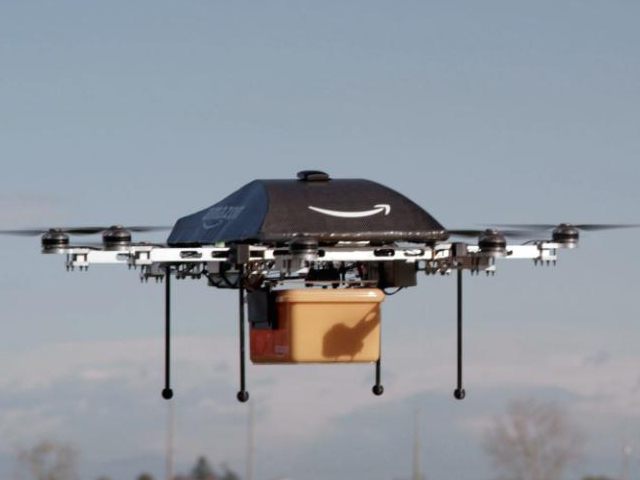Google’s 60-year lease to co-locate with NASA’s Ames Research Center at Moffett Field in Mountain View, California, which was signed in November 2014, appears to be paving the way for the formation of a partnership between NASA, Google and Amazon to develop and roll out an automated national air traffic control system for drone flights.
On Tuesday, NASA opened its first Unmanned Aerial Systems (UAS) Traffic Management Convention to encourage hundreds of drone makers, regulators, engineers and others to debate the future of commercial drone activity. The meeting will run through Thursday to trumpet plans to launch what NASA terms as the “Persistent System” to manage the expected growth of commercial drone uses for surveillance, search and rescue, low altitude radar, agriculture, cargo delivery, media and entertainment.
Amazon.com went all-in for the future of drone delivery in April 2015 when it hired Sean Cassidy, the former number-two executive at the Air Line Pilots Association, Alaska Air Group Inc. pilot, and former member of a Transportation Security Administration aviation-security advisory committee. Amazon tasked Cassidy with convincing FAA regulators to approve widespread commercial drone use.
A month later, the Federal Aviation Administration announced an agreement to join with the Department of Transportation in planning the development of a proposed framework of regulations to facilitate integrate commercial drones under 55 pounds into the U.S. aviation system. The FAA proposal was expected to address height restrictions, operator certification, aircraft registration, markings, and operational limits.
Gur Kimchi, who heads Amazon’s Prime Air division, said in his keynote speech on Tuesday that it was crucial to restrict radio-controlled “hobby drones” to operate operate at the lowest elevations to avoid running into the speedy Internet-connected and auto-piloted aircraft that Amazon’s Prime Air and hundreds of other companies plan to fly.
Amazon’s plan, unveiled on Tuesday would reserve a high-speed race track between 200 and 400 feet above the ground for automated delivery drones, including its Prime Air’fleet. Rather than an independent swarm of fast food, retail and commercial drones racing around in a haphazard fashion over populated areas, Amazon described a vision of tiered and highly synchronized freeways where participants would in concert.
“Right now, you have Google, Amazon and a few others developing large-scale commercial drone operations”, says convention facilitator Parimal Kopardekar of the NASA Ames Research Center. “But maybe in 10 years, every home will have a drone, and every home will act as an airport.”
Kopardekar has been leading an Ames project for the last two years to develop a multi-layered drone management system in the Moffett Field’s massive Hanger One, which was designed to house World War II blimps. NASA hopes to avoid catastrophic accidents such as the 1956 collision of two commercial airliner airliners over the Grand Canyon, which led to a federal takeover of the U.S. air traffic control system.
Conference attendees were warned that there have already been incidents of unlicensed personal drones interfering with California firefighters, buzzing airports, and flying in the vicinity of TV news helicopters, Kopardekar emphasized. “We need to have a system in place before the volume builds” in order to make sure we don’t repeat history.
The NASA conference is also expected to cover the need to insure public privacy. The issue has been especially hot in Congress ever since Sen. Dianne Feinstein (D-CA) testified last year as a special witness at a Commerce Committee hearing on drone policy to discuss her concerns after she caught a drone peeking into her home.
Dave Vos, head of Google’s Project Wing drone division, has said that Google, Inc. is focused on developing a plan to bring the same type of order out of the potential chaos of flocks of commercial drones that it brought to the Internet.
The company has partnered with Amazon.com, Inc., Verizon Communications, Inc. and Harris Corp. to work with NASA to develop the capability for a cloud-based control system that redundantly tracks drone traffic using radar, satellites and cellular networks.

COMMENTS
Please let us know if you're having issues with commenting.